The Body’s Upstairs at Hangover House
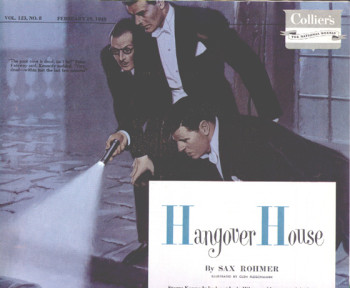
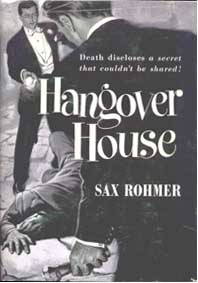 Sax Rohmer’s last title to receive a hardcover edition in the US during his lifetime was Hangover House. It was Rohmer’s final showing on the bestseller lists and his only novel published by Random House. It was first serialized in Collier’s from February 19 to March 19, 1949 prior to its hardcover publication by Random House in the US and Herbert Jenkins in the UK.
Sax Rohmer’s last title to receive a hardcover edition in the US during his lifetime was Hangover House. It was Rohmer’s final showing on the bestseller lists and his only novel published by Random House. It was first serialized in Collier’s from February 19 to March 19, 1949 prior to its hardcover publication by Random House in the US and Herbert Jenkins in the UK.
Interestingly, Collier’s had published an earlier iteration as the short story, “Serpent Wind” in their November 7, 1942 issue. This story was part of a series later collected in book form in 1944 by Robert Hale as Egyptian Nights in the UK and by McBride & Nast under the title Bimbashi Baruk of Egypt in the US. “Serpent Wind” was retitled “The Scarab of Lapis Lazuli” for its hardcover publication. The story later appeared under its original title in the anthologies, Murder for the Millions in 1946 and Horror and Homicide in 1949.
Both story and novel had their origins in an unproduced stage play entitled The Body’s Upstairs which Sax and Elizabeth Rohmer wrote together based on a real life incident at their 1938 New Year’s Eve party at their home in Surrey. Hangover House refers to what today might be termed a “crash pad” for a group of upper class revelers whose overindulgence and indiscretions lead to both adultery and murder in this fast-paced mystery which is easily Rohmer’s best traditional detective story.
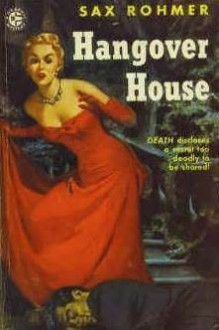
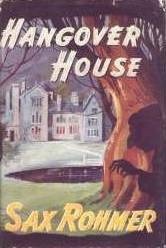 Remarkably the tale spills out over the course of just two days as the actions of the remaining partygoers, now murder suspects, are detailed at some length. Part of this unique structure and pace are tied to the story’s theatrical origins. Bits and pieces (particularly the early chapters as well as the recurring comic relief character who appears throughout the book) reveal the staginess at the story’s heart, but overall the adaptation from theater to novel is much smoother than the previous year’s The Shadow of Fu Manchu (1948).
Remarkably the tale spills out over the course of just two days as the actions of the remaining partygoers, now murder suspects, are detailed at some length. Part of this unique structure and pace are tied to the story’s theatrical origins. Bits and pieces (particularly the early chapters as well as the recurring comic relief character who appears throughout the book) reveal the staginess at the story’s heart, but overall the adaptation from theater to novel is much smoother than the previous year’s The Shadow of Fu Manchu (1948).
The protagonist, Storm Kennedy is not one of Rohmer’s more distinguished detectives. Kennedy is set apart from the pack mainly because he’s smitten with his client’s daughter before he is even assigned the case. As is usual with Rohmer, his love stories are pure hokum with little thought to how the characters will overcome the complexities of social differences, skeletons in their closets, and habitual behavior that would, in all likelihood, derail most attempts at a monogamous relationship. Rohmer, of course, sticks to a fantasy love conquers all approach in his fiction in spite of his own marriage being derailed multiple times by his extra-marital affairs, his recurring desire to return to the bohemian life he once embraced, and his irresponsible spending habits.
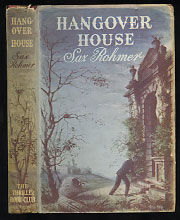 The real key to the book’s success are the well drawn and unique supporting players who include an embittered veteran of Britain’s colonial past who feels his nation’s ideals have been compromised by the new socialist government; an alcoholic womanizing husband whose wealthy wife does her best to put a brave face on their marriage; a promiscuous entertainer who is accustomed to hiding her intelligence around men; a fish out of water Muslim visitor who knows too well that foreigners are never trusted or welcome when crimes have been committed; and others. Rohmer’s eye for detail rarely lets him down and despite being past retirement age when the book was written, he was still at the top of his game with this uncharacteristic but wholly successful mystery devoid of the sensationalistic touches readers had come to expect from his pen. As a final note, Rohmer dedicates the novel to his wife “who helped to write it.” Hangover House remains their most successful collaboration and a title deserving of re-evaluation.
The real key to the book’s success are the well drawn and unique supporting players who include an embittered veteran of Britain’s colonial past who feels his nation’s ideals have been compromised by the new socialist government; an alcoholic womanizing husband whose wealthy wife does her best to put a brave face on their marriage; a promiscuous entertainer who is accustomed to hiding her intelligence around men; a fish out of water Muslim visitor who knows too well that foreigners are never trusted or welcome when crimes have been committed; and others. Rohmer’s eye for detail rarely lets him down and despite being past retirement age when the book was written, he was still at the top of his game with this uncharacteristic but wholly successful mystery devoid of the sensationalistic touches readers had come to expect from his pen. As a final note, Rohmer dedicates the novel to his wife “who helped to write it.” Hangover House remains their most successful collaboration and a title deserving of re-evaluation.
William Patrick Maynard was licensed by the Sax Rohmer Literary Estate to continue the Fu Manchu thrillers beginning with The Terror of Fu Manchu (2009; Black Coat Press) and The Destiny of Fu Manchu (2012; Black Coat Press). The Triumph of Fu Manchu is coming soon from Black Coat Press.